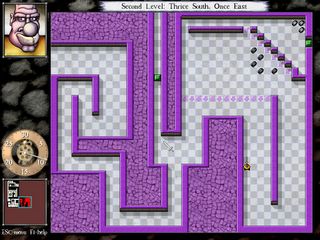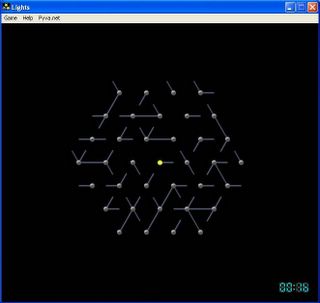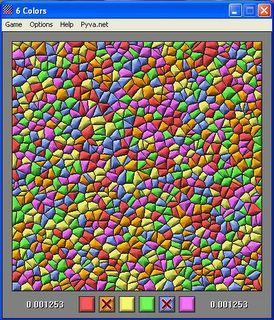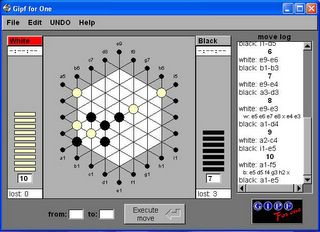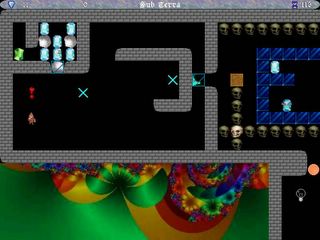Name: Loderunner: The Legend Returns
Author: Sierra
License: Commercial
Website: abandoned
It has been a busy week. So, I am going to pull out a classic. I hope you do not mind a history lesson.
I first played Loderunner on the Apple II back in 1984 (give or take a year) and immediately fell in love.
That version was developed by Doug Smith and released by
Broderbund. It had a near perfect combination of simple rules and good level design plus a fun factor which is hard to quantify. I spent many an hour playing through the 150 levels several times. Then using the level editor, my brother and I made many challenging levels for each other. Soon afterwards, Championship Loderunner was released with 50 tough levels. Yes, sometimes the levels require some tricky finger work and/or fine timing, but it is mostly a thinker's game.
Just in case there is anybody out there who has not played Loderunner, let me give a quick overview. It is platform game in which you play Jake Peril. Your goal is to collect all of the gold chests and then make your way to the exit. Standing between you and success are the bungling mad monks. They chase you around the map. If one comes into contact with you, game over. Your only weapon is an ability to temporarily drill out certain types of floor tiles just to your left or right. Monks will fall into these traps and stay there for a short while allowing you to pass over them. On several levels, you also have to use your drilling ability to gain access to some of the gold.

In 1994, Sierra released a remake called Loderunner: The Legend Returns (LR:tLR), and I was in puzzle game heaven once again. It is rare that a remake is actually better than the original, but LR:tLR does it. They added several new items: bombs, keys, goop which significantly slows down you and the monks when passing through it, caves in which you can hide, and a couple more. My favorite new feature is the spot light. On these levels, you can only see a small circle around Jake; the rest of the screen including the position of the monks is hidden. Even with the additions, the game keeps it old feel and most importantly its fun factor.
There are 150 levels in LR:tLR divided into 10 groups of 15 with cut scenes between groups. The levels are the heart of the game and well done. The pacing is just right, introducing new items and increasing in difficulty at a comfortable pace. Any level can be played at any time, although you lose the ability to appear in the high score list by skipping a level. And a level editor is included.
Despite being over ten years old, LR:tLR plays just fine on Windows XP machines. However, it only uses 480x640 resolution and appears as a small window on today's monitors. A minor flaw. Another complaint is that the AI for the monks is really bad. They often get stuck and are not super aggressive at chasing you down. My final minor complaint is that red monks blend into the backgrounds for some pallets. Do not let any of this stop you giving this game a try.
About a year after LR:tLR came out, Sierra released a small upgrade called Loderunner On-Line: The Mad Monks' Revenge. I was not able to get my copy to run on any of current computers. My memory is that it was not a huge improvement over LR:tLR, but it did allow you to play 2-player cooperative levels on-line.
It appears that LR:tLR has fallen into abandoned status. You can get it at the usual
abandonware sites. There are several online Loderunner resources. The best is probably
Jason's Loderunner Archive. It contains patches and user made levels. One set of user made levels is the 150 from the original Loderunner and the 50 from Championship Loderunner. Also, they have a list of
minor flaws in the rules. These do not really effect the levels which come with LR:tLR, but some user made levels take advantage of them. Another good source on LR:tLR is
here.
Over the years there have been many Loderunner remakes and clones. Caiman Free Games has a whole
category on Loderunner type games. I want to mention two of them. The first is the official sequel called
Loderunner 2. This version is 3-dimensional played from an isometric view. In this version, Jake can drill in any one of four directions. They also improved the monk AI. There are three types of monks with different AI routines. However, the controls are clunky, and it just does not have the same magic as the original.
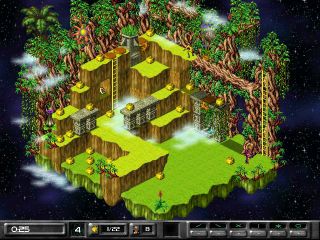
The other is
N. This game has a wonderfully fluid motion and excellent physics model. The British version of
PC Gamer listed N in their list of the best 100 games ever this last Summer. In N, the ratio between fancy finger work and thinking tips towards the finger work, but this is still must try freeware game for any Loderunner fan.

